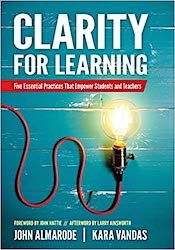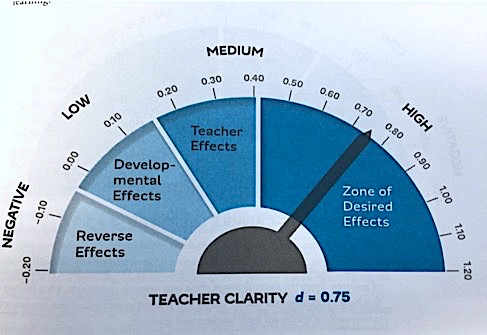 Learning should not be a mystery to students. Yet, too often it is. Walking into a classroom, you might hear a student respond to the question: “What are you learning?” by describing the task at hand:
Learning should not be a mystery to students. Yet, too often it is. Walking into a classroom, you might hear a student respond to the question: “What are you learning?” by describing the task at hand:
“I’m completing a worksheet,” or “I’m writing a book report on this book,” or “I’m completing a report on a our science experiment.” or “We have to do these math problems.”
In every case, the student is describing the task, not the learning. What if instead we heard the following answers:
- “I’m learning how to solve two-step math problems”
- “I’m learning how figurative language influences the plot”
- “I’m learning about dark matter and why it is important”
The difference between the first set of answers and the second is that students are clear about the purpose of their learning. This is a critical difference, according to John Hattie, whose meta-research has found teacher clarity to be one of the most important learning interventions available to us.
Clarity: Learning Intentions/Targets PLUS
Teacher clarity is more than simply posting student-friendly learning targets. It’s also about helping students gauge their own progress through the use of success criteria and intentional and deliberate feedback.
If you are interested in learning more about using clarity in your classroom or across your school and district, I have a book for you: Clarity for Learning: Five Essential Practices That Empower Students and Teachers, by John Almarode and Kara Vandas.
 With a foreword written by John Hattie, the book is perfectly aligned with the professional learning we’ve facilitated over the years, from Ron Berger’s Leaders of Their Own Learning to Antonetti and Stice’s Powerful Task Design.
With a foreword written by John Hattie, the book is perfectly aligned with the professional learning we’ve facilitated over the years, from Ron Berger’s Leaders of Their Own Learning to Antonetti and Stice’s Powerful Task Design.
Best of all, what really grabbed my attention in the book is the emphasis on the use of success criteria, accompanied by countless authentic examples from real classrooms at every grade level.
Five Essential Practices
The authors suggest five practices that, if used consistently and accurately, will result in greater teacher clarity and the ability of students, over time, to self-manage their learning. The practices are:
- Crafting learning intentions and success criteria.
- Co-constructing learning intentions and success criteria with learners.
- Creating opportunities for students to respond (i.e. formative assessment).
- Providing effective feedback on and for learning.
- Sharing learning and progress between students and teachers.
Two chapters address each practice. The first chapter explicates the practice, and the second chapter provides examples of teachers and students using that practice. Additionally, the book features two very useful appendices. The first is a quick reference guide providing the definition of key terms and clear examples to help the reader quickly understand concepts like learning intentions, success criteria, learning progressions, etc.
Using GPS (Gauging the Progress of Students)
Throughout the book, the authors suggest teachers use the following questions with students to move toward clarity:
- What am I learning? (learning intentions/targets)
- Why am I learning it? (both clarity and motivation)
- How will I know I have learned it? (success criteria)
These questions may remind you of Rick DuFour’s four big questions for a Professional Learning Community: (1) What is it that we want students to know and be able to do? (2) How will we know if they get there? (3) What do we do if they don’t get there? and (4) How do we accelerate the learning for those who do get it?
Categories of Clarity Problems
Answering the three questions proposed by Almarode and Vandas requires clarity for the teacher and understanding by the students. Unfortunately, this is not yet the rule in many classrooms.
According to the authors, the frequent lack of clarity presents itself in five different ways:
(1) Fragmented teaching and learning;
(2) Activity-driven instruction;
(3) Misaligned strategies;
(4) Lack of progress monitoring of learning; and
(5) Unhelpful assessment data.
In Clarity for Learning, each of these problems is thoroughly explained, and helpful examples are offered. The book also provides strategies and examples of how to overcome clarity problems. Readers are encouraged to self-assess using tools like:
Practical Examples. Common Misconceptions.
Throughout the book, the authors leave nothing to chance. They provide a wide variety of examples of how to identify learning intentions/targets and the accompanying success criteria. And they address common misconceptions. For example, they help the reader differentiate between success criteria and learning progressions (p. 41):
In short, success criteria and learning progressions are connected. If the success criteria represent what students will do to achieve the learning intentions, then the learning progression represents the pathway or incremental steps that begin with prerequisite skills and concepts and progress as we travel forward through the learning process to achieve each success criterion.
Video Clips
Nothing beats seeing a practice in action. The book gives the reader that opportunity by providing access to online videos. For example: click on the image below to watch a conference between a teacher and a fourth-grade student about writing. The conference is organized around the success criteria the teacher and class co-developed covering important aspects of narrative writing.
Antidote to Students “Playing School”
Clarity for Learning provides a roadmap for teachers and schools interested in deeply engaging their students in learning. And, it might ensure that when students are asked about their learning, they’re able to quickly respond with what, why, and how I will know, rather than just describing the task – or worse, responding by saying, “I don’t know. Ask the teacher.”
To learn more about teacher clarity,
watch this free Corwin webinar with co-author Kara Vandas.




0 Comments on "Hattie Says Teacher Clarity Is One of the Top Learning Interventions. Here’s How It Works."